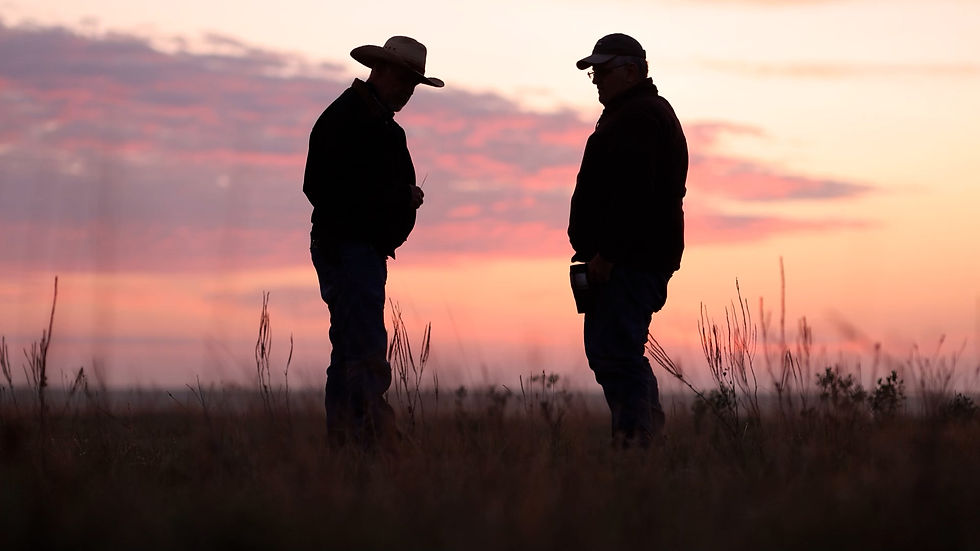Fire, Grazing, and the Long Patience of Grassland Restoration
- Buz Kloot, Ph.D.

- Sep 30
- 4 min read

In July's Our Amazing Grasslands video, courtesy of SD Grassland Coalition, we marveled at the hidden value in so-called weeds — goldenrod testing out as rich as alfalfa, prairie clovers, and milkweeds that feed both cattle and monarchs. That story, framed by Joe Dickie's steady lens, left us thinking of diversity not as decoration but as sustenance.
This August's Our Amazing Grasslands video features SDSU's Pete Bauman walking us onto different ground — sometimes his own pasture, land worn thin by decades of use. The thread that runs through them is not a quick fix, but the long, occasionally frustrating patience of grassland restoration.
When the Prairie Talks Back
When we posted that July goldenrod story on Facebook, the responses lit up like a prairie fire.
Some were intrigued: "My sheep will hit the goldenrod, sunflowers, amaranth, giant ragweed first on paddock moves"
Others dismissed it: "I never saw anything eat goldenrod. I wiped it out with weed killer" A few added nuance: "You have to graze Goldenrod when it is young, six inches to maybe a foot high"
And plenty rejected it outright: "Sadly if you actually looked at grazed pastures you would see cows avoid it. Until you deal with that no cow farmer will plant it."
That chorus of contradiction is instructive. It isn't that the forage analysis was wrong. It's that context matters: species ID, timing of grazing, class of livestock, even regional traditions of what's considered "good" or "bad" forage.
Pete's restoration work echoes that same lesson. Fire might be the great truth teller, but grazing is the long conversation.
The Abused Remnant
At one stop, Pete stands in what was once a dairy farm site, now overrun with Kentucky bluegrass, smooth brome, and thistle. The soil was never turned, but the natives had been grazed down and pushed aside until they hardly whispered anymore. Pete calls this "Phase Zero" — the raw starting point.
Here, the tools are simple but demanding: rest, patience, and eventually fire. Graze too soon before a planned burn and the fuel vanishes; rest long enough and the brome shoots to four feet, laying down the firepower you need. Fire, in turn, reveals what still lives underground. But Pete is clear: if fire isn't possible, well-timed grazing in spring, followed by getting off before July, can also coax natives back into the light
The Personal Pasture
Later, Pete takes us to his own place — a remnant so degraded he could barely coax 1,000 pounds of forage per acre. "Brome, bluegrass, quack grass, Canada thistle — that was it," he recalls. For a while, he fought thistle with the backpack sprayer, growing bitter and weary. Then he shifted: rest, then fire, then more rest. Seed gathered from a small restoration plot, scratched into the ash by family and friends. Livestock brought in cautiously, on his terms.
Now, after twenty years, the story is different. Big bluestem, Indian grass, blazing stars, prairie clover, echinacea — a quilt stitched back together, though never without thistle. The undesirables never vanish, but the natives take their seats at the table again.
The Long Game of Management
Across the sites, Pete circles back to the same refrain: choose your tools wisely! Fire tells the truth of what's still in the seedbank, but it only works if paired with rest. Grazing can pressure cool-season exotics, but only if timed to give natives their window in mid-summer. Spray has its place, but spray alone won't bring back the prairie.
And always, patience. A burn today might not show results for three years. A season's rest can feel like wasted forage until the natives rise again. "Sometimes it takes a few years for that plant community to talk back to us," Pete says.
Through Joe's Lens
Once again, Joe Dickie helps us see what Pete means. The camera lingers on smooth brome, on the surprising flush of bluestem, on the uneasy coexistence of thistle and sunflower. It's the kind of slow, attentive seeing that mirrors Pete's own message: restoration is not spectacle but steady work.
Closing thought: If July's lesson was that diversity has dollar value, August's reminder is that restoring that diversity demands time, restraint, and a willingness to listen. Between fire and grazing, rest and patience, the prairie still knows how to heal itself — if we let it.
Some related blog work that we’ve done may be a helpful supplement to this, they include:
Diversity into Dollars: Rethinking What Forage Is Really Worth: https://www.growingresiliencesd.com/post/diversity-into-dollars-rethinking-what-forage-is-really-worth
Do Cows Eat More Than Grass? What Ranchers Are Learning About Weeds and Forbs: https://www.growingresiliencesd.com/post/do-cows-eat-more-than-grass
How the Michalski Ranch Turned Marginal Cropland into a Diverse, Profitable Pasture: https://www.growingresiliencesd.com/post/how-the-michalski-ranch-turned-marginal-cropland-into-adiverse-profitable-pasture
Visit these “Growing Resilience Through Our Soils” information pages:
1. Podcast page for drought planning fact sheets, Q&As, news, podcasts, and more.
2. Video page to watch videos of other ranchers’ journeys toward improved rangeland/pasture.
3. Follow Growing Resilience on social media:
4. Our homepage: www.growingresiliencesd.com





Comments